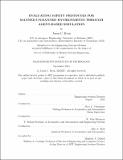Evaluating safety protocols for manned-unmanned environments through agent-based simulation
Author(s)
Ryan, Jason C. (Jason Christopher)
DownloadFull printable version (25.02Mb)
Other Contributors
Massachusetts Institute of Technology. Engineering Systems Division.
Advisor
Mary L. Cummings.
Terms of use
Metadata
Show full item recordAbstract
Recent advances in autonomous system capabilities have improved their performance sufficiently to make the integration of unmanned and autonomous vehicles systems into human-centered civilian environments a realistic near-term goal. In these systems, such as the national highway system, mining operations, and manufacturing operations, unmanned and autonomous systems will be required to interact with large numbers of other unmanned vehicle systems as well as with manned vehicles and other human collaborators. While prior research provides information on the different methods of controlling unmanned vehicles and the effects of these methods on individual vehicle behavior, it has typically focused on only a small number of unmanned systems acting in isolation. The qualities that provide the desired behavior of an autonomous system behavior in isolation may not be the same as the characteristics that lead to desirable performance while interacting with multiple heterogeneous actors. Additionally, the integration of autonomous systems may include constraints on operations that limit interactions between manned and unmanned agents. It is not clear which constraints might be most effective in promoting safe operations and how these constraints may interact with unmanned system control architectures. Examining the effects of unmanned systems in these large, complex systems in reality would require significant capital investment and the physical construction and implementation of the un- manned vehicles of interest. Both of these aspects make empirical testing either difficult or impossible to perform and may also limit the ability of testing to fully examine all the parameters of interest in a safe and efficient manner. The objective of this thesis is the creation of a simulation environment that can replicate the behavior of the unmanned vehicle systems, manned vehicles, and human collaborators in the environment in order to enable an exploration of how parameters related to individual actor behavior and actor interactions affect performance. The aircraft carrier flight deck is chosen as an example domain, given that current operations require significant interactions between human collaborators and manned vehicles and current research addresses the development of unmanned vehicle systems for flight deck operations. Because the complexity of interactions be- tween actors makes the creation of closed-form solutions of system behavior difficult, an agent-based modeling approach is taken. First, a list of actors and their characteristic tasks, decision-making processes, states, and parameters for current aircraft carrier flight deck operations was generated. Next, these models were implemented in an object-oriented programming language, enabling the definition of independent tasks, actors, parameters, and states. These models were later extended to incorporate features of unmanned vehicle control architectures by making minor modifications to the state, logic functions, or parameters of current agents (or tasks). This same tactic can be applied by future researchers to further pursue examinations of other in influential aspects of system performance or to adapt the model to other domains. This model, the Multi-Agent Safety and Control Simulation (MASCS), was then compared to data for current flight deck operations to calibrate and partially validate simulation outputs, first addressing an individual vehicle task before proceeding to mission tasks utilizing many vehicles at once. The MASCS model was extended to incorporate models of different unmanned vehicle control architectures and different safety protocols that affect vehicle integration. These features were then tested at different densities of mission operations on the flight deck and compositions (unmanned vs. manned) of missions in order to fully explore the interactions between variables. These results suggest hat productivity on the flight deck is more heavily influenced by the safety protocols that in influence vehicle integration as opposed to the types of unmanned vehicle control architecture employed. Vehicle safety is improved by increasing the number of high-level constraints on operations (e.g. separating unmanned and manned aircraft spatially or temporally), but these high-level constraints may conflict with implicit constraints that are part of crew-vehicle interactions. Additional testing explored the use of MASCS in understanding the effects of changes to the operating environment, independent of changes to unmanned vehicle control architectures and safety protocols, as well as how the simulation can be used to explore the vehicle design space. These results indicate that, at faster operational tempos, latencies in vehicle operations drive significant differences in productivity that are exacerbated by the safety protocols applied to operations. In terms of safety, a tradeoff between slightly increased vehicle safety and significant increases in the risk rate of crew activity is created at faster tempos in this environment. Lastly, the limitations and generalizability of the MASCS model for use in other Heterogeneous Manned-Unmanned Environments (HMUEs) was discussed, along with potential future work to expand the models.
Description
Thesis: Ph. D. in Human Systems Engineering, Massachusetts Institute of Technology, Engineering Systems Division, 2014. This electronic version was submitted by the student author. The certified thesis is available in the Institute Archives and Special Collections. Cataloged from student-submitted PDF version of thesis. Includes bibliographical references (pages 217-230).
Date issued
2014Department
Massachusetts Institute of Technology. Engineering Systems DivisionPublisher
Massachusetts Institute of Technology
Keywords
Engineering Systems Division.